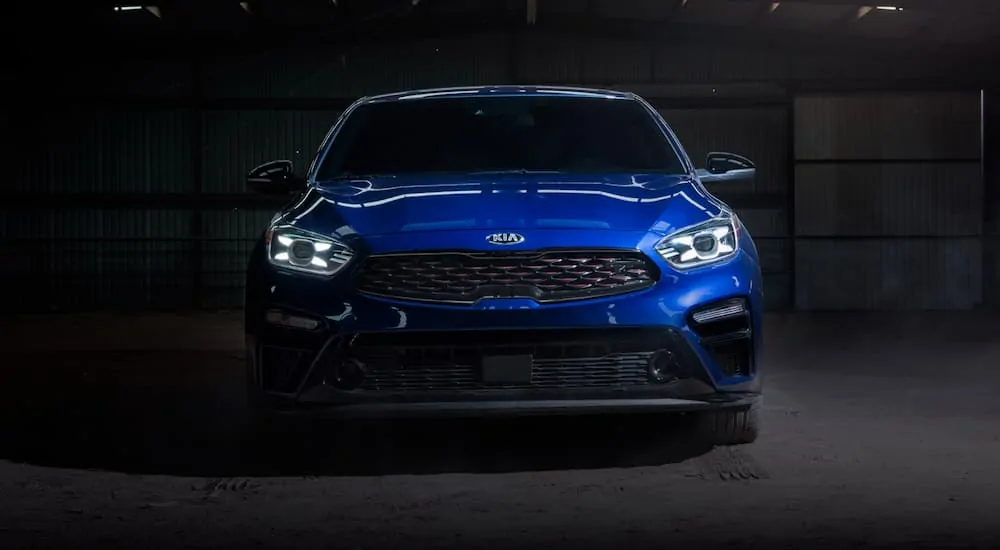Savvy car buyers seeking a vehicle that doesn’t break the bank but still offers a fun driving experience and desirable features have a few surprising options. Though car prices are becoming as onerous as mortgage loans, some car manufacturers are making choices to offer vehicles that don’t require you to drive a vehicle dating back to the previous century. If you know a sedan is a good fit for your lifestyle, you may be considering the 2020 Kia Forte and 2020 Toyota Corolla as viable options.
Both of these vehicles have respectable features, low starting prices, and drive comfortably. To see how these two vehicles match up in terms of design, fuel efficiency, comfort, technology, and safety, we will compare the specifics to decide which vehicle offers the best value. One of the best features of both cars is that they start at an MSRP below $20,000. The 2020 Kia Forte starts at $17,890, and the 2020 Toyota Corolla starts at $19,825.
Design
Just because you don’t want to pay a lot for a new car doesn’t mean you have to sacrifice appearance. Take the Kia Forte; this sedan’s design is based on Kia’s sleek sports car, the Stinger. In particular, the Forte’s front end resembles the grille of the Stinger, but the body is an echo of its sporty sibling, too. A practiced eye will see the differences, but a glance might fool someone into thinking you’re driving an award-winning sports car. Even in its third generation, this car looks young and vibrant. From the prominent front end to the classy shape of the body, this sedan doesn’t look like its price suggests.
On the flip side, the Toyota Corolla just received a redesign for 2020, and Toyota’s pressroom states that the design team’s working phrase for inspiration was “shooting robust.” While that phrase may have inspired the design team, the new Corolla design doesn’t pull off the sporty youthful appeal of the Kia. To be fair, the Corolla has definitely given a facelift to the previous generations, which were in need of updating. While the new Corolla takes a few cues from the much sportier Camry, which shows up most noticeably in the grille and front end, it has a somewhat slumpy look to its lines from front to back. If anything, the Corolla will probably still just blend into the crowd of sedans in a parking lot.
If we go further and compare the sport trims for both the Forte and the Corolla, the Corolla SE is the sporty trim and has metallic rocker panels, metallic gray grille, alloy wheels with gray accents, and metallic gray spoiler on the exterior. The interior accents are sport seats, a three-spoke steering wheel, and paddle shifters with a 2.0-liter four-cylinder engine under the hood. A sport-tuned suspension is also added to stiffen the ride for better control.
Kia’s Forte has the GT model, which adds red accents to the front grille, wheels, and rear diffusers while placing black accents on the mirror caps, side sills, and rear lip spoiler. The already sporty appearance does get bumped up several notches, and then the interior adds red stitching to the sport seats and D-shaped steering wheel, along with stitching along the gear shift leather cover. Under the hood is a turbocharged 1.6-liter four-cylinder, added to which you gain an independent rear suspension, more powerful front brakes, and dual exhaust pipes.
Anyone going for style is going to want the Kia. Toyota has made an excellent effort in redesigning Corolla, but Kia has taken the sporty appeal farther and has produced a classier-looking sedan. To have a sport trim with the attributes of the Kia for just over $20,000 almost seems too good to be true. Corolla just doesn’t hold a candle to the Kia in this category.
Fuel Efficiency, Comfort, and Capacity
To talk about fuel efficiency, we first have to talk about engines. For the Kia Forte, you have two engine options. The first is a 2.0-liter four-cylinder with an intelligent variable transmission or 6-speed manual. The second engine is a turbocharged 1.6-liter four-cylinder with a six-speed manual or seven-speed automatic transmission.
The 2.0-liter engine when equipped with the automatic transmission, has a good estimated fuel efficiency rating of 31 MPG in the city and 41 MPG on the highway. The turbocharged 1.6-liter engine when equipped with the automatic transmission has an estimated rating of 27 MPG in the city and 35 MPG on the highway. Those are fairly high numbers for efficiency.
Toyota’s Corolla has a 2.0-liter four-cylinder engine that can be equipped with either a CVT or a 6-speed manual transmission. The Corolla also offers a 1.8-liter four-cylinder with a CVT or the 6-speed manual transmission. The estimated fuel efficiency is on par with the Kia Forte, offering drivers up to 31 MPG in the city and 40 MPG on the highway with the 2.0-liter engine with the CVT. As for the 1.8-liter engine with the CVT, Corolla drivers can expect an estimated 30 MPG in the city and 38 MPG on the highway.
Interior comforts like a tilting and telescoping steering wheel, remote keyless entry with trunk release, steering wheel-mounted cruise control, six-way adjustable front seats, and manual AC are base trim standard equipment for the Forte. Going up in trim levels offers a 10-way powered driver’s seat with lumbar, dual zone automatic AC, heated and ventilated front seats, leather-wrapped gear shift and steering wheel, and a smart key with push-button start and immobilizer.
In contrast, the Corolla offers a tilting and telescoping steering wheel, steering wheel-mounted cruise control, six-way adjustable driver’s seat with four-way passenger seat, and manual AC for the base trim. Upper trims include eight-way powered front seats, automatic AC, heated front seats, leather-trimmed steering wheel, and a smart key with push-button start and trunk release. In this realm, Kia has a slight advantage depending on what you value for interior comforts.
Last here is the interior space. The Corolla seats up to five passengers and has a cargo capacity of 13.1 cubic feet, has 42 inches of front legroom, and 34.8 inches of rear legroom. Kia’s Forte also seat five, has a cargo capacity of 15.3 cubic feet, has 42.2 inches of front legroom, and 35.7 inches of rear legroom. What does all this mean? You can fit more in the trunk of the Kia, and you have slightly more room when you’re seated. Not much, but every inch counts in a small sedan.
Technology
A surprisingly generous amount of technology comes standard with both the Kia and Toyota sedans, and any buyer will be pleased by how much you get even for the base level trims. Kia comes out of the gate with both Apple CarPlay and Android Auto for all trims, plus an eight-inch touchscreen, Bluetooth, two 12-volt outlets, integrated rear-view camera, steering wheel-mounted audio and phone controls, and a USB jack for multimedia. Remember, this is the base trim. Upper-level trims gain a Harmon Kardon audio system, UVO eServices, voice recognition, Sirius XM, wireless phone charger, and voice-activated navigation.
The base trim for the Toyota comes standard with Apple CarPlay and Amazon Alexa, Siri Eyes Free, Bluetooth, seven-inch touchscreen, one 12-volt outlet, integrated rear-view camera, steering wheel-mounted voice and audio controls, and a USB jack for multimedia. Upper trims add a remote keyless entry or smart key with push-button start, Qi wireless charging, additional USB ports, a JBL sound system, and Sirius XM.
Again, an impressive list of technology. Depending on individual preferences, some buyers may not mind the lack of Android Auto from the Corolla, and may not mind the lack of keyless entry on the lower trim level. Plenty of buyers may prefer getting more features standard for the base trim of the Kia over having to purchase a more expensive car to gain the features in the Corolla. Kia comes out with a better deal for the money.
Safety
In terms of safety, Toyota has made a name for itself when it comes to safety ratings on vehicles. The Corolla is no exception, but Kia has an award-winning vehicle in the Forte. The 2020 Kia Forte won the 2020 IIHS Top Safety Pick Award for the trim levels equipped with forward collision avoidance and LED headlights. Taking into account the whole vehicle, both are designed to withstand impacts structurally, with airbags engineered to sense passengers and lessen the impact, and structural reinforcements also protect passengers.
Kia’s driver-assisted safety features make for another long list. It begins with forward collision avoidance, blind-spot collision warning, lane-keeping assist, traction and stability control, brake assist system (to detect emergencies and apply brakes), vehicle stability management (added steering control as intervention and correction), electronic brake force distribution (distributes brake pressure via sensors), and electronic stability control (helps maintain vehicle direction and reduces engine power in case of impact).
Toyota has also equipped the Corolla with a bevy of safety features like pedestrian detection, lane departure alert with steering assist, road edge detection with sway warning, automatic high beams, road sign assist, lane tracing assist, and radar cruise control. The Star Safety System incorporates vehicle stability management, traction control, electronic brake distribution, brake assist, and Smart Stop Technology.
In this category, it might be a draw. Both vehicles offer incredible amounts of engineering and technology to ensure the safety of passengers. More safety features are added with upper trims on both vehicles, and crash prevention systems are present for both, too. No matter which car you choose for safety, you can trust that the car has countless systems in place to prevent, mitigate, and then assist you after an accident.
So Which Model is Supreme? The Kia Forte or the Toyota Corolla?
No doubt about it, the 2020 Kia Forte and the 2020 Toyota Corolla are fairly well-matched competitors. It’s a paper-thin wedge between which vehicle is the better pick, but if you go with price alone, the Kia is definitely far less expensive for what you gain. Even the base trim level tech and features are fairly well-appointed. Those who enjoy the appeal of a sports car may prefer the Kia GT trim, which allows you the feel of driving a sports car without having to pay for one.
For interior conveniences and space, the Kia barely edges out the Corolla, as with the technology onboard. For safety, the two are relatively well-matched, and it’s anybody’s game. Though it’s a close call, the Kia has to be the front-runner here, if for no other reason than it looks fun and it costs a lot less.






